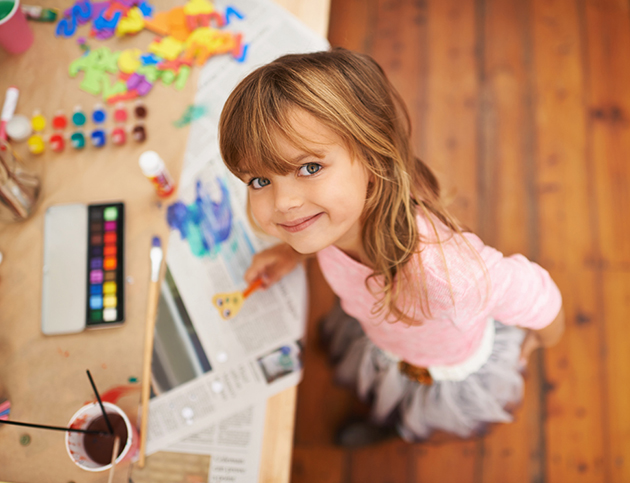
Nothing strikes fear into the hearts of parents faster than when learning rain is due during the school holidays. Here’s our top tips for helping you and your adorable offspring avoid cabin fever.
Sharon Butterworth enjoys rushing in where most of us fear to tread.
A veteran of the child care sector, she juggles working in a busy creche where part of her duties include running an active program for two to five-year-olds in a leisure centre facility alongside her part time job as a presenter with Crocodile Encounters.
Armed with a strong art and craft background, Butterworth believes drawing and painting to be an essential part of child care.
She says not only does it encourage and fosters many skills necessary for a child’s development, it can also be used to help children further develop their fine motor skills, as well as stimulate their senses.
“Children can use art to express emotions and boost self-confidence, learn about colours and textures and most of all, they can have fun. Rainy day craft days can be a real-life saver for both parents and children as working on craft projects can relieve boredom and be used as a bonding time and it can be a great de-stresser for all parties.”
Butterworth’s favourite projects include:
- Paper bag puppets These are great as you can then set up a ‘puppet show’ and continue the fun. You can purchase paper bags from the supermarket quite cheaply. To decorate, just use items such as wool for hair, stickers for eyes, ribbons, felt etc. Children can create different characters or animals or even do self-portrait puppets. The possibilities are many.
- Diorama This is a 3D model in which you can create a scene of your choice. All you need is a box turned sideways which becomes the ‘stage’. A popular and easy theme is under the sea. Children can use make fish and other sea creatures out of paper, cellophane and cardboard. They can be embellished with foil, old sweet wrappers, cotton wool etc. the inside of the box can be painted blue or green. Fish and sea creatures can be hung or stuck to the sides and floor of the scene.
- Stained glass windows All you need for these are firm paper or soft cardboard coloured cellophane and scissors. Patterns can be created on the paper or cardboard by folding it and cutting shapes into the folded edges. Once opened up you create a pattern of holes. These are then decorated by gluing different coloured cellophane onto the back of the paper. When placed on the window the light shining through makes a pretty stained glass effect.
- Sewing cards These are great to make as not only do you make the card but you then get to practice sewing skills. You need cardboard and a single hole punch for this as well as scissors, wool and sticky tape. To make, you simply cut a shape out of the cardboard and decorate with pencils or crayons. Punch holes around the outside of the shape, evenly spaced. Then take a piece of wool, long enough to be sewn around the shape. Tie this to one of the holes to secure, then wrap a small piece of sticky tape at the other end of the wool to stop from fraying.
- Threading For this you can use a variety of different materials depending on the age and development of the child. For older children you can use fishing wire and small beads or buttons. For younger children you can use wool or thick cotton and a variety of items to thread. Some ideas are: Large buttons, coloured cardboard with holes punched, large beads and coloured pasta.
Butterworth says contrary to popular opinion getting together a few items to use for art and craft – including blocks of canvas, acrylic paints, paintbrushes, crayons, pencils and glue – need not be an expensive process.
Aside from basic items found around the house, there are a lot of haberdashery and discount stores which provide great quality art and craft materials at an affordable cost, she says.
“Basic items found around the house can become part of exciting craft projects. Toilet roll and kitchen roll insides, egg cartons, cardboard boxes, old clothes, pegs, bottle tops and paper plates are just a few things that can transform into wild animals puppets or even a bit of abstract art.”
Butterworth recommends looking at Kidspot, The Canvas Factory and Happiness is Homemade for further inspiration on further ways to allow kids to get creative.











